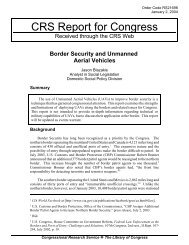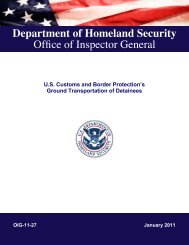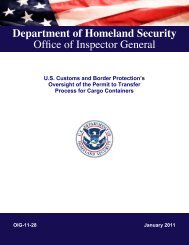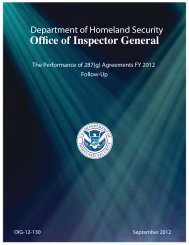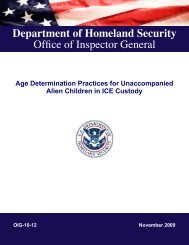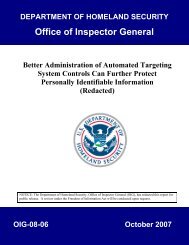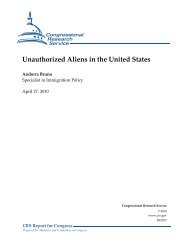Asylum and "Credible Fear" Issues in U.S. Immigration Policy
Asylum and "Credible Fear" Issues in U.S. Immigration Policy
Asylum and "Credible Fear" Issues in U.S. Immigration Policy
You also want an ePaper? Increase the reach of your titles
YUMPU automatically turns print PDFs into web optimized ePapers that Google loves.
<strong>Asylum</strong> <strong>and</strong> “<strong>Credible</strong> Fear” <strong>Issues</strong> <strong>in</strong> U.S. <strong>Immigration</strong> <strong>Policy</strong>Notes: In order to be <strong>in</strong>cluded <strong>in</strong> this TRAC analysis, the court had to have at least four judges who made 50 ormore asylum decisions <strong>in</strong> each time period.The disparities were also evident when immigration court decisions were analyzed by the asylumseeker’s country of orig<strong>in</strong>. As Table 2 <strong>in</strong>dicates, TRAC analysis of decisions on PRC asylumseekers cont<strong>in</strong>ued to show wide disparities <strong>in</strong> the New York court, rang<strong>in</strong>g from 4% to 74%denial rates. The denial rates of Iraq asylum seekers were the lowest, spann<strong>in</strong>g from zero to 4%,<strong>and</strong> their variation was also the lowest at 4%. In contrast, the denial rates of Salvadoran asylumseekers were the highest, spann<strong>in</strong>g 90% to 98%, with only a 8% variation. 68Selected <strong>Issues</strong>Although there are many who would revise U.S. asylum law, those advocat<strong>in</strong>g change havedivergent perspectives. Some cite the seem<strong>in</strong>gly <strong>in</strong>explicable disparities <strong>in</strong> asylum approvals rates<strong>and</strong> urge broad-based adm<strong>in</strong>istrative reforms. Others argue that given the religious, ethnic, <strong>and</strong>political violence <strong>in</strong> various countries around the world, it has become more difficult todifferentiate the persecuted from the persecutors. Some express concern that U.S. sympathies forthe asylum seekers caught up <strong>in</strong> the current political upris<strong>in</strong>gs <strong>in</strong> the Middle East, northern Africa,<strong>and</strong> South Asia could <strong>in</strong>advertently facilitate the entry of terrorists. Others ma<strong>in</strong>ta<strong>in</strong> that currentlaw does not offer adequate protections for people flee<strong>in</strong>g human rights violations or genderbasedabuses that occur around the world. Some assert that asylum has become an alternativepathway for immigration rather than humanitarian protection provided <strong>in</strong> extraord<strong>in</strong>ary cases. Atthe crux of the issue is the extent to which an asylum policy forged dur<strong>in</strong>g the Cold War isadapt<strong>in</strong>g to the compet<strong>in</strong>g priorities <strong>and</strong> turbulence of the 21 st century. Some of these issues arehighlighted below.U.S. National InterestsSome have asserted that U.S. asylum policy attracts asylum seekers who have weak or bogusclaims <strong>and</strong> that additional safeguards are needed to curb abuses <strong>and</strong> protect U.S. national<strong>in</strong>terests. One critic has concluded that the “U.S. asylum system has become the hole <strong>in</strong> the fencefor millions of dubious claimants—<strong>and</strong> a major immigration magnet <strong>in</strong> itself.” Others havema<strong>in</strong>ta<strong>in</strong>ed that migration “push” factors, such as rapid population growth, poverty, <strong>and</strong> political<strong>in</strong>stability <strong>in</strong> the send<strong>in</strong>g countries of asylum seekers, are factors over which the United States haslittle control. Some have warned of “the ongo<strong>in</strong>g separation of asylum from any ground<strong>in</strong>g <strong>in</strong> thenational <strong>in</strong>terest” <strong>and</strong> argued for a serious exam<strong>in</strong>ation of the forces that propel asylum seekers. 69In contrast, others have asserted that the United States should re-calibrate asylum policy toprovide more protections for asylum seekers, ma<strong>in</strong>ta<strong>in</strong><strong>in</strong>g that it is <strong>in</strong> the United States’ national<strong>in</strong>terest to set an example. These proponents have expressed a desire for the United States toreaffirm its welcome to those who have fled persecution as well as its commitment tohumanitarian efforts. They have argued that some of the statutory revisions <strong>in</strong> 1996 <strong>and</strong> 200568 Ibid.69 David Simcox, Humanitarian <strong>Immigration</strong>: Third World “Persecution” Swamps the West, Negative PopulationGrowth, NPG Forum Paper, 2004, http://www.npg.org/forum_series/spr<strong>in</strong>g04fp.html; <strong>and</strong> Don Barnett, The Com<strong>in</strong>gConflict Over <strong>Asylum</strong>: Does America Need a New <strong>Asylum</strong> <strong>Policy</strong>?, Center for <strong>Immigration</strong> Studies, March 2002,http://www.cis.org/articles/2002/back102.html.Congressional Research Service 29



